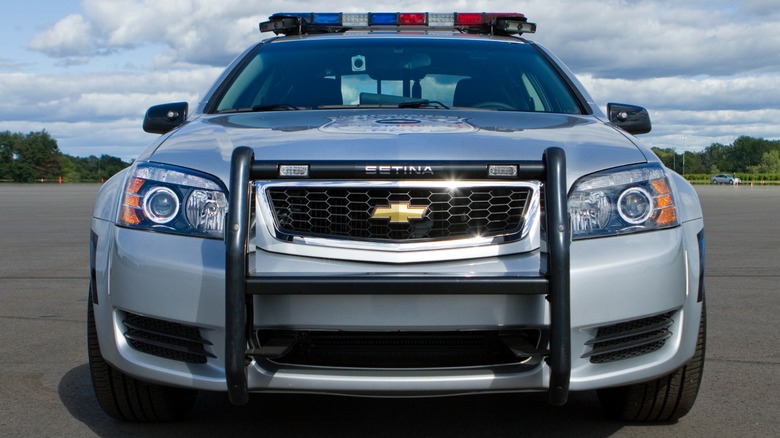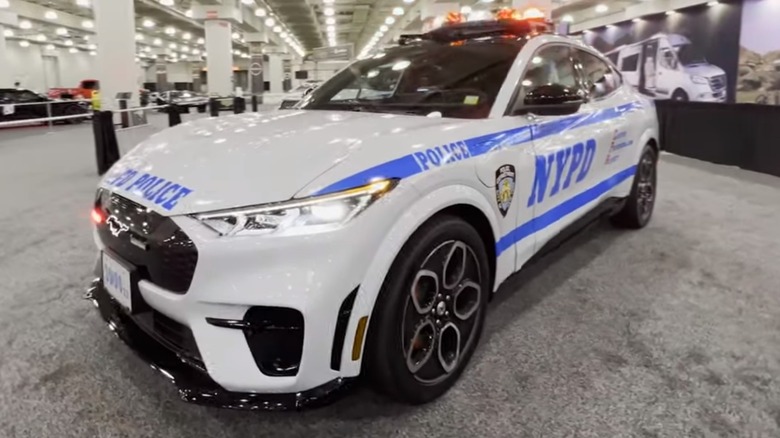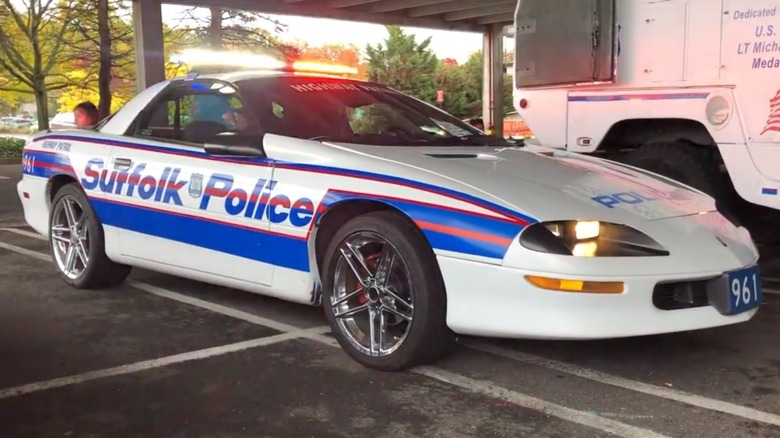8 Of The Fastest Police Cars On The Road In 2024
For nearly as long as we have had cars, we have had police cars. However, it was not until the '50s that manufacturers began making cars specifically for police to buy. In the days of prohibition, which extended in individual states for longer than it did federally, law enforcement found themselves unable to catch up with bootleggers and moonshiners running unregulated booze to markets in modified cars. That practice led to the creation of NASCAR while the official police vehicle debuted at around the same time. Since then, it has been a constant game of "cat and mouse" between criminals and officers in driving the fastest car.
The passing of time has brought many changes to the standard cruiser patrolling our streets. Earlier models featured big engines such as the Magnum 440 and Hemi but not all models were so well-equipped. Eventually, manufacturers offered police versions of popular sports cars such as the widely used Mustang SSP in the '80s and '90s. By the time the new millennium came along, police cars were being equipped with an increasingly long list of specialized equipment including internet-connected computers, onboard radar detectors, high-definition camera arrays, and integrated weapons storage. Furthermore, as engine power output increases across the range of all automobiles, manufacturers are offering police packages with more power than ever.
Since quick acceleration is more important than flat-out speed for most police encounters, these are eight of the fastest-accelerating police cars used for regular duty in 2024.
Chevrolet Blazer EV PPV - 0-60 5.17 seconds (projected)
As more and more police departments have found that an SUV can make for a competent patrol vehicle, manufacturers have been happy to step up and provide them. While Chevrolet has offered its truck-based Tahoe for many years, a more practical and smaller crossover variant is now on the horizon with a new Blazer. This new police-ready model is the 2024 Blazer EV PPV. While the PPV initials stand for Polioce Pursuit Vehicle, you probably noticed the others stand for Electric Vehicle. Yes, the newest Chevrolet offering for police is all-electric and is quite impressive.
While Chevrolet announced this police model in 2022, it is forecasted to be available in the first quarter of 2024. Whether it will see widespread adoption remains to be seen, but by the numbers, it looks pretty good. Based on the SS version of the consumer Blazer model, the EV PPV model is built upon the GM Ultium battery platform with a range of about 250 miles. More importantly, the power output is 498 horsepower and 571 lb-ft of torque, pushed to all four wheels. Other specifications appealing to police fleet managers are its ability to hit 25 mph in reverse, six-piston Brembo brakes for great stopping power, and Firestone Firehawk Pursuit tires as standard.
Mostly, its acceleration time to 60 mph in just 5.17 seconds should give officers the confidence to catch most speeding drivers out there quickly and efficiently.
Dodge Charger Pursuit V8 - 0-60 5.2 seconds
Chrysler vehicles of various brands have been Mopar police cars since at least 1935, with official police packages available from the manufacturer since 1956. They have continued to be used by various departments all over the country in a variety of capacities, with some of the more well-known models used including the Dodge Coronet, Dodge Monaco, Plymouth Belvedere, and Dodge Diplomat. Furthermore, many departments chose Chrysler-powered vehicles to take advantage of the generous power of the cars, such as the California Highway Patrol 440 V8 Polaras of the early '70s.
Today, many departments continue to Mopar police tradition in specially equipped Dodge Charger Pursuit models. Available with either a V6 or V8, these all-American sedans are the last in a long line of traditional four-door police cruisers. While the V6 comes with AWD, the RWD-only V8 comes with a generous 375 horsepower. The 5.7-liter Hemi engine helps officers keep up with the criminals and is aided by a heavy-duty suspension, high-speed engine controller, load-leveling and height control, and added cooling for the engine and engine oil.
These may be the best-looking police cars ever made as the modern Charger is a departure from the common family sedan police cars have been based on for decades. Furthermore, with an acceleration (based on Car and Driver tests of the 2015 model) from 0 to 60 mph in 5.2 seconds, they are also one of the fastest, particularly for a large sedan with all factory-supplied options.
Ford F-150 Lightning Pro SSV - 0-60 3.8 seconds
It is unclear just how many departments will choose to add these to their fleets, but Ford offers a version of its electric full-size pickup for police with its Ford F-150 Lightning Pro SSV. Shortly after introducing the F-150 Lightning, Ford also presented the F-150 Lightning Pro, which is meant to be a work truck variant that comes a bit light of the accessory list but focuses on the power and capabilities of a truck. This is also the version of the Lightning used to create the SSV variant.
This Lightning comes with either the standard battery providing 452 horsepower and 775 lb-ft of torque with an extended-range option providing an increased 580 horsepower. With either choice, officers and deputies have a dual-motor powertrain spinning all four wheels. Furthermore, these offer Ford's Pro Power Onboard, which could be indispensable in emergency responses where first responders can benefit from having power available that can handle a significant load, and the massive front trunk can carry loads of gear.
While these are unlikely to serve traffic duty on city streets, the possibilities in which it could be beneficial are endless, whether that is for emergency responses or for special event patrols that might normally have a gas-powered cruise idling for hours on end. Regardless, the 3.8-second 0 to 60 mph acceleration time makes it among the fastest units when responding to a call.
Chevrolet Caprice PPV - 0-60 5.3 seconds
The now-defunct relationship between General Motors and Australian Holden produced many interesting automobiles from 1924 until it ceased operations in 2020. Most of the products built by Holden in Australia were only ever intended for domestic consumption and provided Aussies with a range of unique cars for decades. GM technology was woven throughout Holden products, but in 2004, complete models were first exported to the United States as the Pontiac GTO. This event led to the Holden Commodore being exported as the V8-powered Pontiac G8 from 2007 to 2009, with a later model becoming a cop car.
Beginning in 2012, Chevrolet began importing the Holden Caprice as the Chevrolet Caprice PPV. Much to the chagrin of fans of the Pontiac G8, this Holden model was brought stateside and only offered to police departments. While this full-size sedan showed up on our shores looking much like many other typical sedans and family cars of its era, it became a forbidden fruit because of its 6.0-liter LS V8 hiding out under the hood. This squad car with the V8 was good for 355 horsepower and, unlike the contemporary American-made V8 Impala, it was rear-wheel-drive.
Americans would eventually have a chance to buy an Australian muscle car in the form of the 2015 to 2017 Chevrolet SS. For a time, however, they had to watch out for the Caprice PPV as its LS helped the police catch up to you with its acceleration to 60 mph in just 5.5 seconds. While these have all likely been retired by now, there are sure to be plenty still driving.
Ford Mustang Mach-E - 0-60 3.7 seconds
Although some might have thought it was some kind of corporate betrayal to introduce a four-door Mustang, the truth is that Ford's Mustang Mach-E turned out to be a pretty impressive vehicle. It has good range, impressive speed, and excellent interior finish that incorporates modern technology in a package that further benefits from the extensive network of Ford dealers and suppliers ensuring uninterrupted support for the vehicle nationwide.
Ford has never offered a police version of the Mach-E. Regardless, some departments have taken them on in pilot programs for evaluation as regular patrol cars. The cars are relatively spacious and provide a range of 270 miles, which, considering the average patrol car sees about 100 miles a day, should be more than sufficient with the remaining capacity being available for operating an idle vehicle. However, the added electronics and weight of extra equipment will reduce the range somewhat. Oakdale, California has added two of them to its fleet for use by supervisors, while New York City acquired 100 units to the NYPD fleet in its efforts to reduce the environmental footprint of the department.
We may not ever see widespread adoption of the Mach-E for patrolling our streets, but with the stock configuration's acceleration of 5.1 seconds (3.7 seconds if they adopt the GT Performance model) to 60 mph, it could easily catch up with most vehicles on the roads. However, a trial in Michigan found the cars generally unfavorable for police duty, likely killing the prospect altogether.
Tesla Model 3 Performance - 0-60 3.1 seconds
With the longevity of Tesla Motors and its innovation with electric vehicles, the brand would seem like a logical choice for optimizing cars for police duty. Tesla technology is mature, supported by a robust network of chargers and support facilities, making adoption by police departments at least somewhat hassle-free. Consequently, many departments have trialed Tesla cars and many of them patrol the streets right now.
One of the hurdles for departments considering a Tesla is the high purchase price. While this is a factor, the considerable fuel used by a patrol car is a large part of a police department's budget, and those who have already adopted the Tesla say the savings in fuel and maintenance are more than offset over the life of a Tesla. This was confirmed in reporting by Police1. Somerset PD Chief Joel Trepczyk answered questions in 2023 about his department's Tesla fleet, which has been well-received by officers and police administrators alike. Furthermore, Unplugged Performance in California offers Model Y police conversions, and the South Pasadena police department is working toward replacing its entire fleet with Tesla vehicles.
In 2022, Dallas County added three Tesla Model 3 Performance units to its fleet for evaluation. This model was a smart choice as it has a generous range of 310 miles with 0 to 60 mph acceleration of a blindingly fast 3.2 seconds. Criminals beware.
Chevrolet Camaro B4C
Ford first offered its Mustang SSP to law enforcement agencies in the '80s, quickly picking up customers across the country, particularly those with highway patrol. Chevrolet management could not be left out of this action as the Camaro B4C began to be offered in 1991, lasting through the 2002 model year.
With the B4C package, departments received cars equipped with the same drivetrain from the top-performing Z/28 package along with heavier front and rear sway bars, high-output alternators, four-wheel disc brakes on later models, oil coolers for engine, transmission, and power steering, and certified 145 mph speedometers. By the final year of production, troopers could take full advantage of the LS1 V8 under the hood to catch up with speeders thanks to the output of 325 horsepower, pushing the B4C-equipped Camaro from a trooper's speed trap hideout to 60 mph in a scant 5.2 seconds. While these have been decommissioned for some time, at least a few have been restored and still roam the streets, albeit now in an unofficial capacity.
Nissan GT-R - 0-60 2.9 seconds
Nissan's Skyline GT-R was forbidden fruit to American car buyers for years as no exports for the North American market were ever produced. Yet, Nissan finally relented and sent over an export version in 2008 badged simply as the GT-R. The Nissan halo car became an instant success thanks to its twin-turbo V6 pushing 480 horsepower to all four wheels. Finally, Americans could buy a reasonably affordable sports car with similar performance to exotic imports from Italy, including criminals or cops.
Back in 2011, a video surfaced online of a 2012 GT-R model undergoing modifications by Emergency Vehicle Installations Corp., a company outfitting vehicles for law enforcement use. This particular GT-R remained painted in its factory color with no exterior markings of any kind. However, the video does show it array of hidden and embedded emergency lights and modifications to the factory LED lights giving them strobe effects. Motor Trend reported on this car, speaking with an official from the company who said the work was being done for an undisclosed law enforcement agency. Furthermore, an Instagram post from 2022 shows a video of a GT-R with emergency lights activated having someone pulled over in New Jersey, although the details are not confirmed.
Regardless of which agency uses this car, its 0 to 60 mph time of 2.9 seconds means few people have any hope of escaping it.








